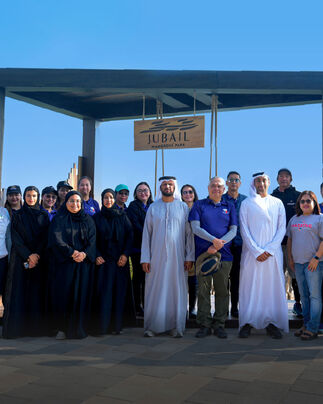Environment Agency – Abu Dhabi (EAD) will begin remotely measuring vehicle emissions on the roads of Abu Dhabi using the latest innovative technology.
In partnership with 4 Earth Intelligence Environmental Consultancy LLC (4EI) and Hager Environmental & Atmospheric Technologies (HEAT) of the US, EAD will be using HEAT’s patented NASA Spinoff remote-sensing system, EDAR (Emissions Detection and Reporting), which will detect and quantify on-road emissions measurements using its laser-based overhead detectors in real time. The testing period will last for three weeks and be conducted across six different locations in Abu Dhabi.
Through this non-intrusive technology, EAD will be able to accurately detect and quantify various gases being emitted from the tailpipe of a moving vehicle in real time. This is in addition to identifying the vehicle licence plate number, which is used only to acquire technical information of the vehicle, like brand, model, fuel type, emission standard and vehicle weight. No personal data will be used in this study.
The initiative is a part of the Integrated Air Quality Management Programme established by EAD. The initiative will establish a baseline for future policies and regulations, identify the main emitting vehicle classes and technologies, and help support the design of effective mitigation measures. The study will also establish the input data for air quality modelling, develop local air and greenhouse gas (GHG) emission factors, while enhancing academic research and innovation projects.
Her Excellency Dr Shaikha Salem Al Dhaheri, Secretary-General of EAD, said: “At EAD, our core mandate is ensuring the best quality of life for everyone living in Abu Dhabi and that our air quality is of the highest standards. This project is a major step in the right direction for us to contribute to Abu Dhabi government’s vision of the city being the most liveable in the world.
“We know that the transport sector contributes to pollutants in the air and we want to be scientifically certain that we have the latest research at hand to be able to make correct and well-informed decisions. This will facilitate our capability to implement the most effective policies for the greater good of the community. We are always keen to use the latest advanced technology and, through remote sensing of vehicle emissions, we will be able to gather real-time data without disrupting traffic. Using the accumulated data, we will be able to devise mitigation plans and programmes so that we can reduce emissions entering the air we breathe, further improving residents’ safety and wellbeing.”
David Critchley, CEO of 4EI, said: “At 4EI, we are immensely proud to work alongside EAD and HEAT on this important project. EAD’s vision to be the first government agency to bring this groundbreaking technology to the GCC shows how high Abu Dhabi’s commitment is to cleaner air. 4EI is committed to using remote sensing services for the betterment of the planet and humans – this is another example how government initiatives and private technology and knowledge can come together in improving our environment.”
Yolla Hager, President of HEAT, said: “This joint venture is paramount in setting up Abu Dhabi for even greater environmental success. We must see the bigger picture and work toward sustainability – with the public and private sectors joining forces to improve air quality through reduced harmful vehicle emissions.”
EAD will also partner with three significant entities in Abu Dhabi, which include Abu Dhabi Police, Department of Municipalities and Transport (DMT) and Integrated Transport Centre (ITC). The project entails EAD remotely measuring vehicle emissions on the roads of Abu Dhabi using cutting edge, state-of-the-art technology.
Through the partnership, Abu Dhabi Police will be responsible for the technical information of the vehicles and traffic management during the monitoring and data collection exercise. DMT will be providing the permits to place EDAR remote sensing equipment on the side of the road and will also manage all other authorisations and approvals. ITC will coordinate traffic flow information and site selection recommendations, such as toll gates, bridges etc.
By using this advanced technology, EAD will be able to automatically process the collected data and coordinate with the concerned authorities to match the remote sensing information and data with those in the vehicle registration databases in the emirate. During the study period, detailed analysis of the data to be collected (such as emissions in kilometres travelled, vehicle type, model year, payload, etc.) will be provided, which will contribute to developing recommendations to reduce the effects of air pollution caused by vehicles.
Eng. Faisal Al Hammadi, Acting Executive Director of EAD’s Environment Quality Sector, said: “Our partners are providing their full support to this exciting new project, which is a first in the region. We are using the most advanced technology for the remote sensing of vehicle emissions in real-time and the large amount of data we will be gathering will be extremely beneficial to us as a scientific body dedicated to research, as well as to our partners specifically. Both the Department of Municipalities and Transport and the Integrated Transport Centre will benefit from the real-time data that will assist in policy-making for the reduction of emissions, as well as have baseline data and information of emissions from the current vehicle fleet in Abu Dhabi. Abu Dhabi Police, through this endeavour, will have access to a comprehensive database of the current vehicle fleet characteristics and information that could help them with the enhancement of the vehicle licensing process.
“However, most importantly on a larger strategic scale, this project will also assist in the development of mitigation programmes for the reduction of harmful pollutants in the air for a healthier emirate of Abu Dhabi for all of its residents. In the future, our partners will help with the alignment of our policies and strategies, as well as provide the required data, information and support to improve knowledge in the transport sector and sub-sectors to support mitigation measures for transport emissions which we know is one of the main causes for pollutants in the air.”
Remote sensing systems use absorption spectroscopy to non-intrusively measure pollutant concentrations in the exhaust plumes of in-use vehicles. A light source is placed above a roadway, with the instrument oriented so that the light beam produced by the source traverses the exhaust plumes of passing vehicles. Each remote sensing measurement lasts for less than one second and yields an estimate of the concentration of pollutants in the exhaust plume. Remote-sensing systems measure nitrogen monoxide (NO), nitrogen dioxide (NO2), carbon monoxide (CO), hydrocarbons (HC), carbon dioxide (CO2), and particulate matter (PM).







